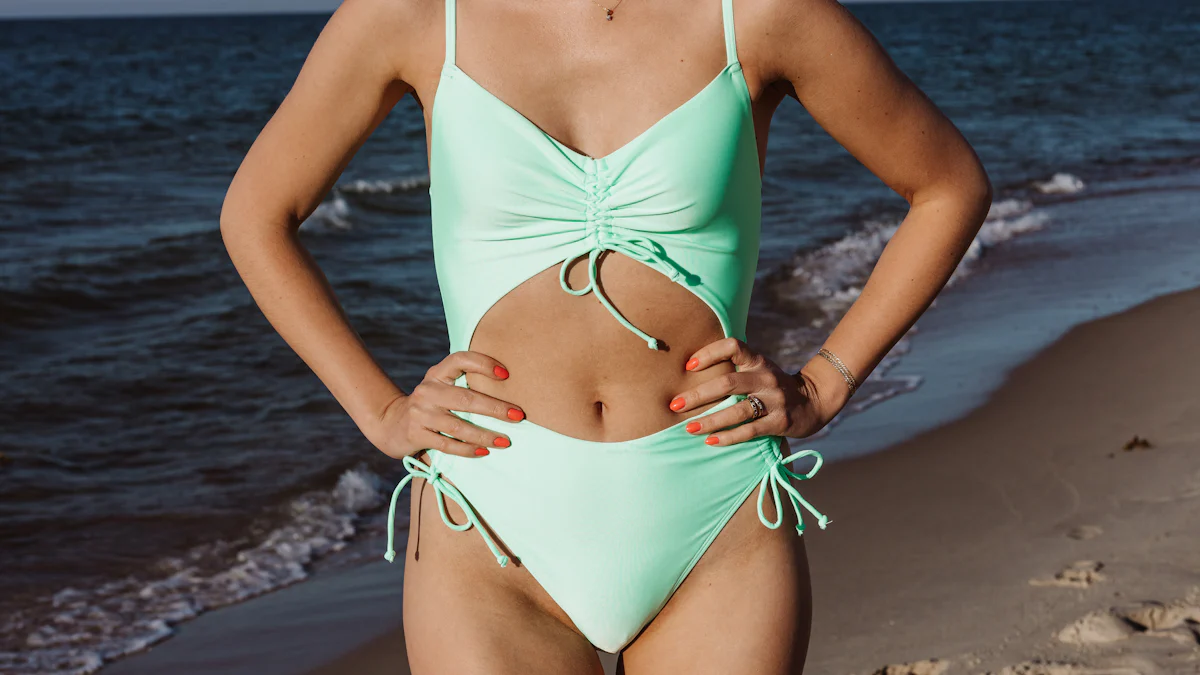
The swimwear industry has a significant impact on the environment, with traditional production methods contributing to pollution and resource depletion. Materials like polyester and nylon, commonly used in conventional swimwear, release harmful chemicals and generate waste that lingers in landfills for decades. Choosing sustainable swimwear offers a solution. By repurposing plastic waste into durable, stylish designs, sustainable swimwear reduces ocean pollution and promotes eco-friendly practices. As a consumer, your choices matter. Supporting brands that prioritize sustainability helps protect the planet while encouraging ethical manufacturing practices.
Key Takeaways
Choosing sustainable swimwear helps reduce ocean pollution and supports eco-friendly practices.
Look for swimwear made from recycled materials like ECONYL and REPREVE to promote a circular economy.
Support brands that prioritize ethical manufacturing practices, ensuring fair labor conditions and transparency in their supply chains.
Certifications like GOTS and OEKO-TEX provide assurance that swimwear meets strict environmental and safety standards.
Your purchasing decisions can drive positive change in the fashion industry by supporting brands committed to sustainability.
Investing in high-quality, sustainable swimwear not only benefits the planet but also ensures durability and long-term savings.
Align your swimwear choices with your personal values by supporting brands that actively contribute to environmental and social causes.
What Makes a Swimwear Manufacturer Sustainable?

Sustainability in swimwear manufacturing goes beyond just creating stylish designs. It involves thoughtful choices in materials, ethical practices, and certifications that ensure minimal environmental impact. Let’s dive into the key factors that define a sustainable swimwear manufacturer.
Use of Sustainable Materials
The materials used in swimwear play a huge role in determining its environmental footprint. Sustainable swimwear manufacturers prioritize eco-friendly fabrics that reduce waste and pollution.
Recycled Fabrics like ECONYL and REPREVE
Recycled fabrics have revolutionized the swimwear industry. ECONYL, for instance, is a regenerated nylon made from discarded fishing nets, fabric scraps, and industrial plastic waste. This innovative material not only reduces ocean pollution but also cuts down the global warming impact of nylon production by up to 90%. Similarly, REPREVE transforms recycled plastic bottles into high-performance fibers, offering durability and sustainability in one package. By choosing swimwear made from these materials, you support a circular economy where waste gets a second life.
Organic and Biodegradable Materials
Some manufacturers go a step further by using organic or biodegradable materials. These fabrics, often derived from natural sources, break down more easily in the environment compared to synthetic alternatives. While not as common as recycled fabrics, they represent a growing trend in sustainable swimwear. Opting for these materials helps reduce long-term waste and supports a cleaner planet.
Ethical Manufacturing Practices
Sustainability isn’t just about materials. It’s also about how swimwear is made. Ethical practices ensure that the people behind the products are treated fairly and that the production process remains transparent.
Fair Labor Conditions and Wages
Sustainable swimwear brands often commit to fair labor practices. They ensure workers receive fair wages and work in safe conditions. By supporting these brands, you contribute to a system that values human rights and dignity.
Transparent Supply Chains
Transparency is key to ethical manufacturing. Brands with clear supply chains openly share where and how their products are made. This openness builds trust and ensures that every step of the process aligns with sustainable and ethical values. When you choose brands with transparent practices, you make an informed decision that aligns with your values.
Certifications and Eco-Labels
Certifications act as a seal of approval, verifying that a brand meets specific sustainability standards. They help you identify trustworthy manufacturers.
GOTS, OEKO-TEX, and Other Recognized Certifications
Certifications like GOTS (Global Organic Textile Standard) and OEKO-TEX ensure that swimwear meets strict environmental and safety criteria. GOTS focuses on organic materials, while OEKO-TEX tests for harmful substances in fabrics. These certifications give you confidence that the products you buy are safe for both you and the environment.
Importance of Third-Party Verification
Third-party verification adds credibility to a brand’s claims. It ensures that manufacturers adhere to sustainability standards without cutting corners. When you see a certification on a product, you know it has been independently verified, making it easier to trust the brand’s commitment to sustainability.
By understanding these factors, you can make smarter choices when shopping for sustainable swimwear. Look for brands that prioritize eco-friendly materials, ethical practices, and reliable certifications. Your decisions can drive positive change in the swimwear industry and beyond.
Top 10 Sustainable Swimwear Manufacturers

1. Tideline Swimwear
Key Features
Tideline Swimwear focuses on creating eco-friendly swimwear using recycled materials like ECONYL. Their designs combine functionality with sustainability, making them a favorite among eco-conscious consumers. The brand also emphasizes durability, ensuring that each piece lasts for years.
Pros and Cons
Pros: High-quality materials, stylish designs, and a strong commitment to sustainability.
Cons: Limited size range and fewer options for budget-conscious shoppers.
Unique Selling Points
Tideline stands out for its dedication to using regenerated fabrics and producing swimwear that balances style and environmental responsibility. If you value long-lasting, sustainable swimwear, this brand is worth exploring.
2. Summersalt
Key Features
Summersalt offers swimwear that’s both budget-friendly and size-inclusive. Their pieces are crafted from eco-friendly materials like recycled fabrics and regenerated nylon. The brand prioritizes comfort and style, ensuring you feel confident in every design.
Pros and Cons
Pros: Affordable pricing, inclusive sizing, and sustainable materials.
Cons: Limited high-fashion options for those seeking more unique or luxury designs.
Unique Selling Points
Summersalt’s accessible pricing and wide size range make it a go-to for sustainable swimwear. Their focus on affordability ensures that eco-conscious fashion is within reach for many shoppers.
“Summersalt offers a collection of conscious swimwear designed with sustainability and style in mind.”
3. Patagonia
Key Features
Patagonia is renowned for its commitment to sustainability and ethical practices. Their swimwear includes durable board shorts and versatile designs that transition seamlessly from the beach to outdoor adventures. The brand also donates 1% of its sales to environmental causes, reinforcing its dedication to protecting the planet.
Pros and Cons
Pros: High-quality craftsmanship, fair trade practices, and a strong environmental mission.
Cons: Premium pricing may not suit all budgets.
Unique Selling Points
Patagonia’s swimwear reflects its broader ethos of sustainability and durability. Their fair trade certification and contributions to environmental initiatives set them apart as a leader in sustainable swimwear. If you’re looking for versatile, eco-friendly options, Patagonia delivers.
“Patagonia is known for its high-quality, sustainable men’s swimwear that can be worn from the beach to the trails and beyond.”
4. Vitamin A
Key Features
Vitamin A stands out for its commitment to eco-friendly practices. The brand uses OEKO-TEX® certified fabrics, ensuring that harmful chemicals stay out of your swimwear. They also incorporate recycled nylon into their designs, reducing waste and promoting sustainability. Another impressive feature is their waterless printing process, which minimizes water and chemical usage during production. By choosing Vitamin A, you support a brand that prioritizes both style and environmental responsibility.
Pros and Cons
Pros: Chic, modern designs crafted with sustainable materials. The brand’s innovative processes reduce environmental impact.
Cons: Higher price points may not suit every budget.
Unique Selling Points
Vitamin A combines eco-friendly certifications with timeless, stylish designs. Their use of lower-impact materials and water-saving techniques makes them a leader in sustainable swimwear. If you’re looking for swimwear that’s both fashionable and planet-friendly, Vitamin A delivers.
5. Londre
Key Features
Londre Bodywear focuses on creating swimwear that’s both sustainable and size-inclusive. Their pieces are made with OEKO-TEX® certified fabrics, ensuring safety for you and the environment. Londre’s production process emphasizes waste reduction, helping to protect natural ecosystems. By choosing Londre, you actively support environmentally responsible practices.
Pros and Cons
Pros: Inclusive sizing ensures a fit for all body types. The brand’s commitment to sustainability is evident in every piece.
Cons: Limited styles may not appeal to those seeking a wide variety of designs.
Unique Selling Points
Londre’s focus on inclusivity and sustainability sets it apart. Their swimwear not only fits beautifully but also aligns with eco-conscious values. If you value ethical production and a perfect fit, Londre is a fantastic choice.
6. Reformation
Key Features
Reformation offers trendy swimwear made from Econyl, a fabric created from recycled plastic bottles. All their products are crafted in their Los Angeles factory, ensuring fair working conditions and a carbon-neutral production process. Reformation’s dedication to using natural and recycled materials makes them a standout in the sustainable swimwear market.
Pros and Cons
Pros: Stylish, on-trend designs made with sustainable materials. The brand’s carbon-neutral operations reflect its commitment to the planet.
Cons: Premium pricing may not be accessible to everyone.
Unique Selling Points
Reformation combines fashion-forward designs with a strong commitment to sustainability. Their use of recycled materials and ethical production practices ensures you can look good while making a positive impact. For those who want swimwear that’s both chic and eco-friendly, Reformation is a top pick.
7. Andie Swim
Key Features
Andie Swim stands out for its affordability and commitment to sustainability. The brand uses FSC-certified materials, ensuring that the fabrics come from responsibly managed forests. Their swimwear combines comfort, durability, and eco-consciousness, making it a great choice for budget-conscious shoppers who care about the planet.
Pros and Cons
Pros: Affordable pricing makes sustainable swimwear accessible to more people. The use of FSC-certified materials reflects their dedication to environmental responsibility.
Cons: The brand offers fewer eco-certifications compared to some competitors, which may concern those seeking a broader range of verified sustainable practices.
Unique Selling Points
Andie Swim’s accessible pricing and focus on sustainable materials make it a fantastic option for anyone looking to make eco-friendly choices without breaking the bank. If you’re new to sustainable swimwear, this brand provides an excellent starting point.
8. Boden
Key Features
Boden offers a variety of budget-friendly swimwear options that don’t compromise on sustainability. The brand prioritizes eco-friendly production methods and uses materials that meet high safety standards, such as OEKO-TEX-certified fabrics. Boden’s designs cater to families and individuals seeking stylish yet affordable swimwear.
Pros and Cons
Pros: Great value for eco-conscious consumers. Their swimwear is stylish, comfortable, and made with safe, sustainable materials.
Cons: Limited high-end or luxury designs may not appeal to those looking for premium swimwear.
Unique Selling Points
Boden delivers exceptional value by combining affordability with sustainability. Their swimwear is perfect for families or individuals who want to make environmentally responsible choices without overspending. If you’re looking for reliable, eco-friendly swimwear that fits your budget, Boden is a top contender.
9. MEDINA Swimwear
Key Features
MEDINA Swimwear brings elegance and sustainability together. The brand focuses on creating stylish swimwear using Econyl, a regenerated nylon made from discarded fishing nets and other ocean plastics. Their designs exude sophistication while supporting efforts to reduce ocean pollution.
Pros and Cons
Pros: Elegant and contemporary designs crafted with eco-friendly materials. The brand’s commitment to sustainability aligns with its luxurious aesthetic.
Cons: Less size-inclusive compared to other brands, which may limit options for some shoppers.
Unique Selling Points
MEDINA Swimwear combines luxury with eco-consciousness. By choosing this brand, you support a mission to protect the oceans while enjoying chic, high-quality swimwear. If you value both style and sustainability, MEDINA Swimwear offers a perfect blend of the two.
10. Salt Gypsy
Key Features
Salt Gypsy stands out for its dedication to ocean conservation and sustainable practices. The brand uses innovative fabrics like ECONYL, a regenerated material crafted from discarded fishing nets, carpets, and industrial plastics. This fabric not only reduces waste but also ensures durability, with colors that resist fading over time. Additionally, they incorporate REPREVE Lycra, made entirely from recycled plastic bottles, into their designs. Their unique prints are created using a sublimation printing process, which eliminates water usage, making it an eco-friendly alternative to traditional methods.
Salt Gypsy specializes in women’s surfwear, offering stylish and functional pieces for surf enthusiasts. However, their swimwear is versatile enough for anyone, regardless of whether you surf or simply enjoy lounging by the water.
Pros and Cons
Pros:
Unique and exclusive prints that stand out.
Durable materials designed to last, even with frequent use.
Strong focus on sustainability and ethical production.
Cons:
Niche appeal, as the designs cater primarily to surf lovers.
Limited stretch in some fabrics, which may affect fit preferences.
Unique Selling Points
Salt Gypsy’s connection to ocean conservation sets it apart. By choosing their swimwear, you actively support efforts to reduce ocean pollution. Their use of regenerated materials like ECONYL and REPREVE Lycra reflects their commitment to sustainability. The brand’s exclusive prints and vintage-inspired designs add a touch of individuality to every piece. Whether you’re hitting the waves or relaxing on the shore, Salt Gypsy offers swimwear that combines style, functionality, and eco-consciousness.
“Salt Gypsy’s mission is to create sustainable surfwear that empowers women while protecting the planet.”
If you’re looking for swimwear that aligns with your love for the ocean and the environment, Salt Gypsy is a perfect choice.
How to Choose the Right Sustainable Swimwear Manufacturer
Choosing the right sustainable swimwear manufacturer can feel overwhelming, but breaking it down into key factors makes the process easier. By focusing on materials, certifications, and transparency, you can make informed decisions that align with your values.
Consider the Materials Used
The materials in your swimwear play a huge role in its environmental impact. Paying attention to fabric choices ensures you’re supporting eco-friendly practices.
Look for Recycled or Organic Fabrics
Recycled fabrics like ECONYL and REPREVE are game-changers in sustainable swimwear. These materials repurpose waste like fishing nets and plastic bottles into high-quality fibers. They not only reduce ocean pollution but also contribute to the circular economy by giving discarded materials a second life. Organic fabrics, though less common, offer another eco-friendly option. Derived from natural sources, they break down more easily in the environment, leaving a smaller footprint.
“High-quality swimwear made from recycled materials ensures environmentally friendly swimsuits.” – Sustainable Swimwear Market Forecast and Advantages
Avoid Harmful Chemicals and Dyes
Many traditional swimwear fabrics rely on harsh chemicals and dyes that harm the environment. Sustainable manufacturers avoid these substances, opting for safer alternatives. When shopping, look for brands that highlight non-toxic production methods. This ensures your swimwear is safe for both you and the planet.
Check for Certifications
Certifications act as a trust signal, showing that a brand meets specific sustainability standards. They help you separate genuine eco-friendly manufacturers from those making empty claims.
Verify Eco-Labels Like GOTS or OEKO-TEX
Eco-labels like GOTS (Global Organic Textile Standard) and OEKO-TEX provide assurance that your swimwear meets strict environmental and safety criteria. GOTS focuses on organic materials, while OEKO-TEX ensures fabrics are free from harmful substances. These certifications give you peace of mind, knowing your purchase supports sustainable practices.
Research the Credibility of Certifications
Not all certifications carry the same weight. Some brands may use lesser-known labels to appear sustainable without meeting rigorous standards. Take a moment to research the credibility of the certifications listed. Trusted third-party verifications, like GOTS and OEKO-TEX, ensure manufacturers adhere to strict guidelines.
“Third-party verification adds credibility to a brand’s claims, ensuring adherence to sustainability standards.”
Evaluate the Brand’s Transparency
Transparency reveals how committed a brand is to ethical and sustainable practices. A transparent company openly shares details about its supply chain and production processes.
Look for Detailed Information on Supply Chains
Brands that prioritize sustainability often provide clear information about their supply chains. They disclose where materials come from and how products are made. This openness builds trust and shows they have nothing to hide. When a brand shares these details, it’s a good sign they’re genuinely committed to ethical practices.
Assess the Company’s Commitment to Ethical Practices
Ethical practices go hand-in-hand with sustainability. Look for brands that treat workers fairly, pay living wages, and maintain safe working conditions. Companies that value ethics often highlight these efforts on their websites or product descriptions. Supporting such brands ensures your purchase aligns with your values.
By focusing on these factors, you can confidently choose a sustainable swimwear manufacturer. Prioritizing recycled materials, verifying certifications, and evaluating transparency not only helps the planet but also ensures you’re investing in high-quality, ethical swimwear. Your choices matter, and they can drive positive change in the fashion industry.
Align with Your Personal Values
Support Brands That Prioritize Fair Labor
Your values matter, and the brands you support should reflect them. Choosing swimwear manufacturers that prioritize fair labor practices ensures your purchase contributes to a better world. These brands uphold high standards for working conditions, fair wages, and worker safety. By supporting them, you help create a fashion industry that values people as much as the planet.
Fair labor practices go beyond just paying workers. They include fostering safe environments and respecting workers' rights. Brands committed to these principles often share their efforts openly. Look for companies that highlight their ethical practices on their websites or product descriptions. Transparency in this area shows they genuinely care about their workforce.
“Ethical production is not just a business practice; it’s a commitment to human dignity and fairness.”
When you choose brands that prioritize fair labor, you’re not just buying swimwear. You’re investing in a system that uplifts communities and promotes equality. Your choices can inspire other companies to adopt similar practices, driving positive change across the industry.
Choose Manufacturers With a Strong Environmental Mission
Sustainability starts with intention. Manufacturers with a strong environmental mission actively work to reduce their impact on the planet. They use eco-friendly materials, minimize waste, and adopt innovative production methods. By supporting these brands, you directly contribute to reducing the fashion industry’s environmental footprint.
Many sustainable swimwear brands go beyond just creating eco-friendly products. They give back to the community and support environmental organizations. For example, some brands donate a portion of their profits to ocean conservation efforts or tree-planting initiatives. This commitment to the planet sets them apart and aligns with the values of eco-conscious consumers like you.
“Every purchase is a vote for the kind of world you want to live in.”
When evaluating a brand’s environmental mission, look for transparency. Companies that openly share their sustainability goals and achievements build trust. They show accountability and a genuine desire to make a difference. Supporting these brands helps grow the market for sustainable fashion and encourages others to follow suit.
By aligning your purchases with your personal values, you become part of a larger movement. You’re not just buying swimwear; you’re advocating for fair labor, environmental responsibility, and a better future. Your choices matter, and they have the power to shape the industry for the better.
Supporting sustainable swimwear manufacturers is more than just a fashion choice—it's a step toward protecting the planet. By choosing eco-friendly materials and ethical brands, you help reduce waste, promote fair labor, and encourage responsible production practices. Your decisions as a consumer have the power to shape the industry, driving demand for better, greener alternatives. Every purchase you make sends a message that sustainability matters. Together, we can create a future where fashion respects both people and the environment. Start making informed choices today and be part of the change.
FAQ
How can I choose sustainable swimwear?
To pick sustainable swimwear, start by checking for certifications like GRS (Global Recycled Standard), OEKO-TEX, or Bluesign. These labels confirm that the swimwear meets strict environmental and safety standards. Research brands that emphasize sustainability and transparency in their production processes. Opt for high-quality, durable pieces to reduce the need for frequent replacements. This not only saves money but also minimizes waste.
Pro Tip: Look for brands that use recycled materials like ECONYL or REPREVE. These fabrics repurpose waste into stylish, eco-friendly swimwear.
What are sustainable alternatives to traditional swimwear fabrics?
Sustainable swimwear fabrics include recycled yarns made from plastic waste, such as discarded water bottles and fishing nets. Materials like ECONYL and REPREVE lead the way in offering durable, eco-friendly options. Unlike traditional synthetic fibers like nylon and polyester, these alternatives reduce pollution and help protect marine life. Some brands also use organic or biodegradable materials, which break down more easily in the environment.
“Sustainable swimwear isn’t just about materials—it’s about creating long-lasting designs that reduce waste and support a cleaner planet.”
Why is sustainable swimwear more expensive?
Sustainable swimwear often costs more because of the higher-quality materials and ethical production practices involved. Recycled fabrics like ECONYL require advanced technology to produce, and brands that prioritize fair labor pay workers fairly and maintain safe working conditions. While the upfront cost may be higher, sustainable swimwear lasts longer, making it a worthwhile investment.
How do I know if a brand is truly sustainable?
Transparency is key. Look for brands that openly share details about their materials, supply chains, and manufacturing processes. Certifications like GOTS, OEKO-TEX, or Fair Trade add credibility to their claims. Check their website or product descriptions for information on their sustainability efforts. If a brand avoids providing clear details, it might not be as eco-friendly as it seems.
Can sustainable swimwear be stylish?
Absolutely! Sustainable swimwear brands offer a wide range of designs, from minimalist styles to bold, trendy patterns. Brands like Vitamin A, Reformation, and Salt Gypsy prove that you don’t have to sacrifice style for sustainability. Many eco-friendly swimwear options feature vibrant colors, flattering cuts, and unique prints, ensuring you look great while supporting the planet.
How long does sustainable swimwear last?
Sustainable swimwear is designed to last longer than traditional options. High-quality recycled fabrics like ECONYL and REPREVE are durable and resistant to wear and tear. Proper care, such as rinsing your swimwear after use and avoiding harsh detergents, can extend its lifespan even further. Investing in sustainable swimwear means fewer replacements, saving you money in the long run.
Are there size-inclusive sustainable swimwear options?
Yes, many sustainable swimwear brands prioritize inclusivity. Brands like Summersalt and Londre offer a wide range of sizes to ensure everyone can find a perfect fit. These brands focus on creating designs that flatter all body types while maintaining their commitment to eco-friendly practices.
What makes recycled fabrics like ECONYL and REPREVE special?
Recycled fabrics like ECONYL and REPREVE transform waste into high-performance materials. ECONYL repurposes discarded fishing nets, fabric scraps, and industrial plastics, reducing ocean pollution. REPREVE, on the other hand, uses recycled plastic bottles to create durable fibers. Both materials support a circular economy, giving waste a second life while reducing the environmental impact of traditional fabric production.
Is sustainable swimwear worth the investment?
Yes, sustainable swimwear is worth it. While the initial cost may be higher, the durability and quality of eco-friendly materials ensure your swimwear lasts longer. By choosing sustainable options, you also support ethical labor practices and help reduce environmental harm. It’s an investment in both your wardrobe and the planet.
How can I care for my sustainable swimwear?
Proper care extends the life of your swimwear. Rinse it with cold water after each use to remove chlorine, salt, or sunscreen. Avoid wringing it out, as this can damage the fabric. Let it air dry in the shade instead of using a dryer. Following these steps keeps your swimwear looking great and ensures it lasts for years.
